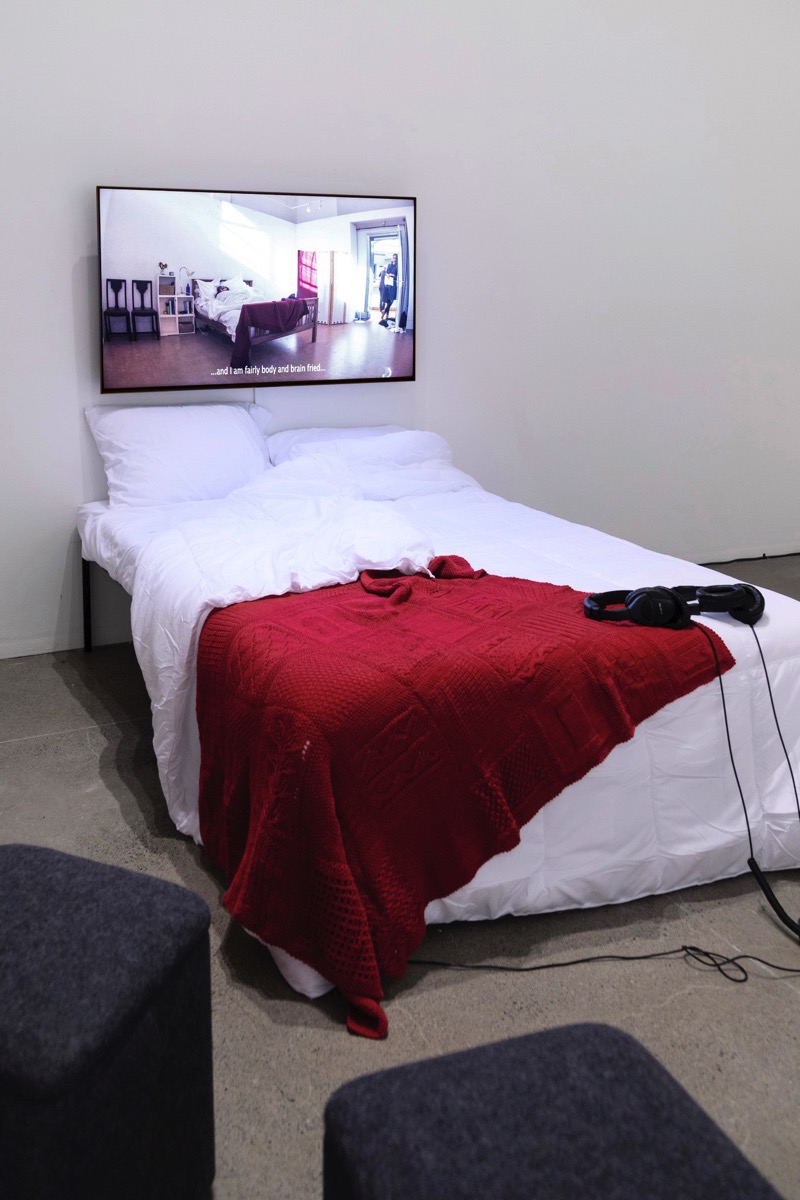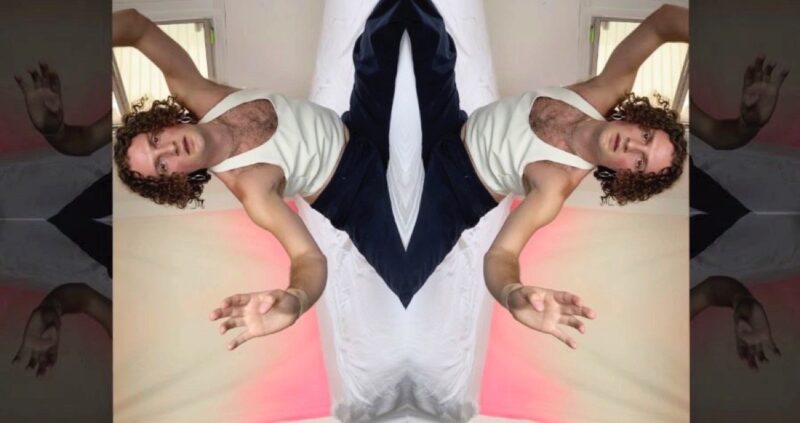[Fall 2024]
De la vie au lit
by Fanny Bieth
[EXCERPT]
As luck would have it, I visited De la vie au lit, an exhibition at Galerie de l’UQAM, on a day when I would have been happy to stay in bed. I say “luck” because I am able-bodied, living with no chronic incapacities, and so I knew that the numbing fatigue and muscle pain I was feeling that day were temporary. Yet, as the show’s curator, Sarah Heussaff, underlined in her presentation essay, being in bed is a daily reality for people with disabilities or an illness. Although the capitalist and ableist system tends to reduce “bed” to a place where we recover in order to gain better (re)productivity, thinking of spending time in bed solely in terms of performance obscures therealities of those for whom being in bed doesn’t arise simply from a need for bodily relief but is also a way of inventing an existence despite the inaccessibility of society and the resulting oppressions. The works in the exhibition, most of them installations, performances, and videos, thus envisaged the bed and the bedside in their private and political dimensions, and as spaces for creation, exchange, and transmission.
The exhibition opened with a relief reproduction of Félix Vallotton’s engraving
La paresse. Dating from the late nineteenth century, the work shows a woman stretched out nude on a bed, a cat by her side. It offered an example of art-historical portrayals of reclining bodies, traditionally apprehended as passive and lazy. A few steps away, Octavia Rose Hingle’s video
Bodyfabric (2020) immediately refuted this perception: a rapid, dynamic montage of sequences shows Hingle dancing in bed and walking in the street with a cane. On the floor, a bass-amplification device enhanced the vibrations of the rhythmic music that accompanies the video. Here, the bed is the context for a choreography expressing a strong vital force – far from the inertia usually associated with that object.
In Tamyka Bullen’s installation and performance Spiral Life (2022), the bed appeared as a place for meditation and authentic sharing. The text of the performance features Jimena, a lesbian who is deaf, at the bedside of her ill mother. Jimena evokes the separation between their worlds and reveals her own difficulties and aspirations. To the right of that work, Rea Sweets’s Love My Dysfunctions (2020) provided a sense of refuge even as it testified to the ableism that permeates the academic world. A tent bathed in red light sheltered a sleeping bag and a pillow, on which a text by Sweets related various instances of discrimination. On the wall, a TV set showed a video of Sweets’s computer screen during an all-night writing session.
Cindy Baker’s Crash Pad (2016) and Liz Crow’s Bedding Out (2012–2013) shared a section that made the bedroom a true community space for care and encounter. The bed in Crash Pad was round – pill-shaped. The bedspread and the wallpaper were composed of a multitude of drawings portraying queer people, overweight and with various incapacities, sharing life moments in a bedroom. Six watercolour versions of these drawings were framed on the wall. Above a bed, a TV set presented Crow’s performance Bedding Out, during which she remained in bed in an exhibition space in the United Kingdom for forty-eight hours, chatting with the audience gathered around her. By portraying the complex reality of a person living with handicaps, Crow aimed to denounce the stereotypes associated with disability. The bed embodied a place both for rest and for sharing and resistance.
At the end of the exhibition space, Salima Punjani’s The Cost of Entry is a Heartbeat (2020) acted as a sanctuary. The multisensory installation was defined by a black curtain. Within were a bed, sofas, and ottomans on which one could sit. On the wall was projected a video made in the thermal baths of Budapest, where the sound ambience was also recorded. Vials containing different scents – rose, coffee, orange, eucalyptus, and more – lent the experience an olfactory dimension; through headphones, Punjani encouraged us to take a collective pause, to appreciate the vibrations that connect us, and to escape, at least for a while, the pressure of productivism.
All of these artworks strongly mobilized the artists’ and the spectators’ bodies. The performances and activations of the artworks that took place during presentation of the exhibition particularly highlighted this involvement. De la vie au lit invited us to listen carefully to all bodies, by offering evidence of their beauty and capacity for resistance. The exhibition underlined the political and cultural aspects of lives spent in bed. Often considered a private, intimate space, the bed thus became the hub of a community, a place as much of expression as of rest.
Heussaff’s curatorial work brilliantly illustrated the importance of promoting accessibility in the art field. So that all individuals could approach the works according to their own needs and preferences, different sensory options were offered: printed texts, braille versions, audio-descriptions, sign-language interpretations, and so on. In addition, accommodations were made, such as an access ramp to Galerie de l’UQAM and a quiet room where one could read zines related to the exhibition’s theme. These practices and devices not only made the art more accessible but enriched the experience of the exhibition for all visitors. Not only should the creative force of artists of diverse abilities be recognized, it is also necessary to rethink our spaces and practices to make them truly inclusive. In this sense, De la vie au lit can be seen as a remarkable example. Translated by Käthe Roth
[ Complete issue, in print and digital version, available here: Ciel variable 127 – SISTERS, FIGHTERS, QUEENS ] [ Complete article in digital version available here: De la vie au lit]




